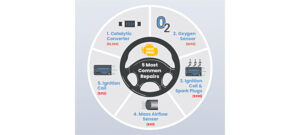Over 280 billion miles that would have been traveled by newer cars and light trucks are being shifted to older light vehicles, boosting aftermarket product sales
Fort Wayne, Ind.—An estimated 14 million fewer new cars and light trucks will be sold in the U.S. between 2020 and 2024 than in the previous five years (2015 through 2019), according the latest Lang Aftermarket iReport.
The downturn in sales is changing the age mix of vehicles on U.S. roads and shifting billions of annual miles from newer to older cars and light trucks, which are virtually all Internal Combustion Engine (ICE) vehicles.
The shift has “significant implications” for aftermarket product use and the growth of car and light truck products on U.S. roads, especially ICE vehicles, stated the analysis.
Here are highlights from the report.
14 Million Fewer New Vehicles Sold
Lang Marketing estimates that over 14 million fewer new cars and light trucks will be sold in the U.S. between 2020 and 2024 compared to the 17.3 million average annual new vehicle sales between 2015 and 2019.
Annual light vehicle sales have decreased an average of 16% since COVID-19. It will take another 3 to 4 years before the new vehicle market returns to its pre-pandemic levels, a longer recovery than that following the 2008 Great Recession.
Annual Mileage by Vehicle Age
Newer vehicles typically are driven more annual miles than older cars and light trucks. Vehicles newer than six years average nearly 14,000 miles per year on U.S. roads compared to fewer than 7,500 miles recorded by the typical car and light truck over 10 years old.
Annual Mileage Shift
With fewer new vehicles sold annually between 2020 and 2024 compared to sales levels from the previous five years, over 280 billion miles that would have been traveled by newer cars and light trucks are being shifted to older light vehicles, which are virtually all ICE models.
Annual Product Use Shift
The 280 billion-mile shift from newer to older vehicles is causing a redistribution of aftermarket product use across vehicle age groups. As older vehicles are driven “harder,” they average greater aftermarket product use per mile than newer cars and light trucks.
Increasing Average Age
In addition to fewer newer cars and light trucks on U.S. roads and a shift in mileage from newer cars and light trucks to older models, the average age of all vehicles continues to climb.
Lang Marketing estimates that the average age of vehicles will reach nearly 13.0 years by 2025, an increase of almost a year from 2019.
This rise in the average age of the nation’s total vehicles in operation (VIO) is a second factor in the increasing age of vehicles recording annual miles on U.S. roads.
Many More than 280 Billion-Mile Shift to Older ICE Vehicles
The decline in newer cars and light trucks, especially those under six years of age, between 2020 and 2024 coupled with the increasing age of all cars and light trucks in operation, means that many more than 280 billion miles will be recorded by older cars and light trucks on U.S. roads between 2020 and 2024 than in 2019.
Future Aftermarket Growth
The increased use of older vehicles (and the greater product and service volume required per mile traveled) will be a primary factor helping to boost car and light truck aftermarket product sales for the foreseeable future.
This is especially true of ICE light vehicles, which account for over 99% of cars and light trucks six years and older across the U.S.







Comments are closed.